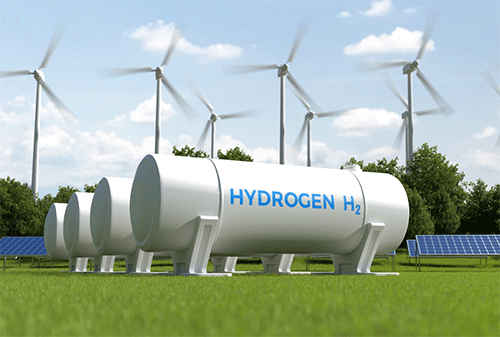With production costs estimated as low as US$2 per kilogramme, Namibia’s green hydrogen could become one of the cheapest options in the world, making the country an attractive partner for energy-hungry entities in the midst of the energy transition.
According to Energy Capital & Power, an African investment platform for the energy sector, Namibia could boost its GDP by US$15 billion (about N$286 billion) to US$20 billion (N$382 billion) per year, create over 100 000 domestic jobs, export 14 GW of clean power to the Southern African Power Pool and reduce GHG emissions by 45 to 60 million tons of carbon dioxide per year by 2040.
Last May, Namibia commissioned sub-Saharan Africa’s largest green hydrogen production plant. The US$10-billion (N$191 billion) project, led by green hydrogen development company Hyphen Hydrogen Energy, is anticipated to be capable of producing 300 000 tons of green hydrogen and ammonia and will feature wind and solar plants with a combined capacity of 7GW.
This year, Namibia is expected to complete development of a 5MW pilot plant, which will act as a testing facility for hydrogen production and handling. Hyphen Hydrogen Energy also signed a deal with finance vehicle SGD Namibia One Fund in December 2022 to secure €23 million (N$477 million) in capital, while collaborating with Japan’s ITOCHU Corporation to enhance the company’s technical capabilities for successful project deployment.
Meanwhile, Namibia’s prospects for offshore oil and gas exploration have resulted in the country becoming a hotspot for hydrocarbon investment in recent years. This is as the country’s ambition to become a global hub for green hydrogen development, on the back of abundant, co-located solar and wind resources, is poised to support value-added industrialisation, economic transformation and regional integration by stimulating exports to international markets.
These and other developments are expected to be unpacked at the Invest in Africa Energy forum scheduled to take place in Paris in May
So far, a quintet of major oil discoveries in the Orange Basin offshore Namibia have placed the country’s upstream oil and gas sector on the precipice of transformation. The Graff-1, La-Rona-1, Jonker-1X, Lesedi-1X and Venus-1 discoveries were made between 2021 and 2023 through a series of exploration campaigns led by supermajors Shell and TotalEnergies and state-owned QatarEnergy.
Last month, TotalEnergies announced its continued exploration in the offshore Orange Basin, with appraisal drilling being conducted south and north-west of the Venus-1 discovery.
These efforts have already resulted in the company intersecting hydrocarbon bearing intervals in the Mangetti-1X prospect, drilled 35km from the Venus-1 discovery.
IAE 2024 is an exclusive forum designed to facilitate investment between African energy markets and global investors. Taking place ion 14 and 15 May, 2024 in Paris, the event offers delegates two days of intensive engagement with industry experts, project developers, investors and policymakers.
Energy Capital & Power further reported that in addition to the Orange Basin, Namibia’s onshore Kavango Basin is thought to hold more than 30 billion barrels of crude oil.
“Last November, E&P company ReconAfrica and its partner Namcor (National Petroleum Corporation of Namibia) gained approval for the second renewal exploration period on PEL 73 in the basin, running from January 2024 to January 2026. During this period, ReconAfrica will lead drilling to test the Damara Fold Belt and oil-prone rift plays in the basin. Meanwhile, oil and gas company 88 Energy signed a farm-in agreement with Monitor Exploration last November to earn up to a 45% non-operated working interest on the onshore PEL 93 in the Owambo Basin. The agreement will involve the acquisition of approximately 200-line-kilometers of low-impact 2D seismic data in mid-2024, along with a potential initial exploration well targeting the Damara gas play in 2025,” Energy Capital & Power stated.
Moreover, with production expected to start in 2026, the Kudu Conventional Gas Field, one of Namibia’s most prolific assets, is currently in its Front-End Engineering Design (FEED) stage and is expected to be operated by oil and gas company BW Energy. Home to nearly 600 billion cubic feet of natural gas reserves, the Kudu Gas development is expected to reach a peak production of 64 million cubic feet per day.
Exemplifying the country’s integrated energy strategy, this recent exploration blitz has the potential to make Namibia one of Africa’s major oil and gas producers, while a wave of new seismic activity is poised to attract new independent and junior explorers to its frontier market.
Boasting an abundance of solar and wind resources, Namibia’s plans to expand power generation capacities are expected to see a share of 60% renewables by 2030.
“Within this timeframe, the country aims to install a total of 510 MW of grid-connected renewable energy capacity.
This ambitious goal will be driven through competitive tenders from local and international IPPs that will be subject to PPAs with Namibia’s state-owned power utility NamPower and regional energy distributors,” Energy Capital & Power stated.
Last December, the Namibia launched a tender inviting consultants to provide services for renewable energy projects spanning solar PV, wind and battery energy storage systems (BESS). Services will include environmental and social impact assessments and site studies for a number of upcoming solar PV and BESS projects.


